
Photo from wikipedia
OBJECTIVE To characterize clinical and laboratory findings in cats with naturally occurring sepsis, emphasizing hemostasis-related findings, and evaluate these variables for associations with patient outcomes. DESIGN Prospective, observational, clinical study.… Click to show full abstract
OBJECTIVE To characterize clinical and laboratory findings in cats with naturally occurring sepsis, emphasizing hemostasis-related findings, and evaluate these variables for associations with patient outcomes. DESIGN Prospective, observational, clinical study. ANIMALS 31 cats with sepsis and 33 healthy control cats. PROCEDURES Data collected included history; clinical signs; results of hematologic, serum biochemical, and hemostatic tests; diagnosis; and outcome (survival vs death during hospitalization or ≤ 30 days after hospital discharge). Differences between cats with and without sepsis and associations between variables of interest and death were analyzed statistically. RESULTS The sepsis group included cats with pyothorax (n = 10), septic peritonitis (7), panleukopenia virus infection (5), bite wounds (5), abscesses and diffuse cellulitis (3), and pyometra (1). Common clinical abnormalities included dehydration (21 cats), lethargy (21), anorexia (18), pale mucous membranes (15), and dullness (15). Numerous clinicopathologic abnormalities were identified in cats with sepsis; novel findings included metarubricytosis, hypertriglyceridemia, and high circulating muscle enzyme activities. Median activated partial thromboplastin time and plasma D-dimer concentrations were significantly higher, and total protein C and antithrombin activities were significantly lower, in the sepsis group than in healthy control cats. Disseminated intravascular coagulopathy was uncommon (4/22 [18%] cats with sepsis). None of the clinicopathologic abnormalities were significantly associated with death on multivariate analysis. CONCLUSIONS AND CLINICAL RELEVANCE Cats with sepsis had multiple hematologic, biochemical, and hemostatic abnormalities on hospital admission, including several findings suggestive of hemostatic derangement. Additional research including larger numbers of cats is needed to further investigate these findings and explore associations with outcome.
Journal Title: Journal of the American Veterinary Medical Association
Year Published: 2017
Link to full text (if available)
Share on Social Media: Sign Up to like & get
recommendations!